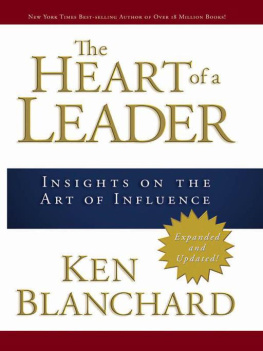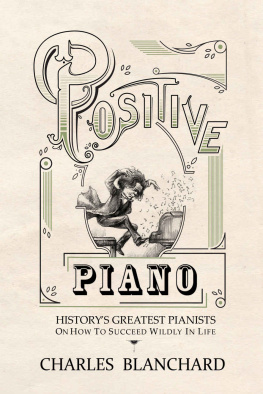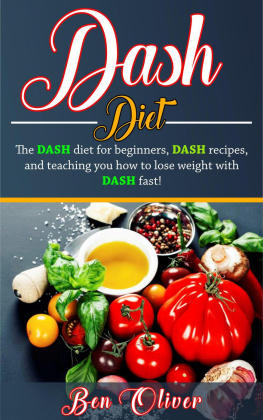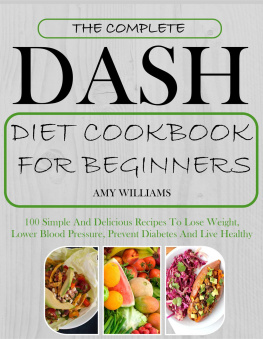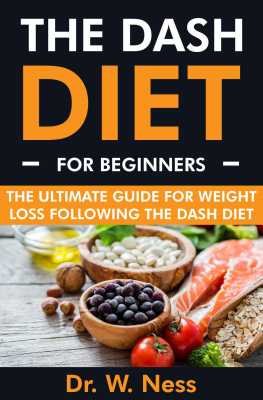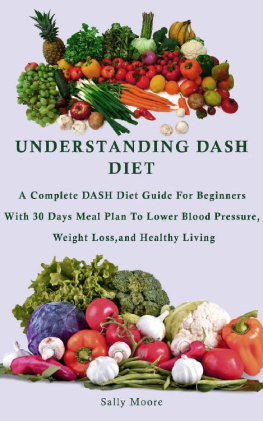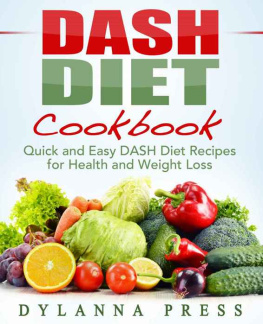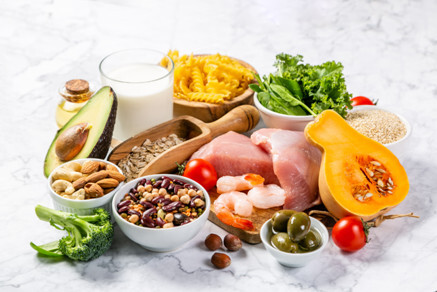DASH
DIET
COOKBOOK
More Than 50 Quick, Easy and Healthy Recipes to Improve Health, Lose Weight and Lower Blood Pressure
MARIE BLANCHARD
Copyright 2020
All rights reserved.
This document is geared towards providing exact and reliable information with regards to the topic and issue covered. The publication is sold with the idea that the publisher is not required to render accounting, officially permitted, or otherwise, qualified services. If advice is necessary, legal or professional, a practiced individual in the profession should be ordered.
- From a Declaration of Principles which was accepted and approved equally by a Committee of the American Bar Association and a Committee of Publishers and Associations.
In no way is it legal to reproduce, duplicate, or transmit any part of this document in either electronic means or in printed format. Recording of this publication is strictly prohibited and any storage of this document is not allowed unless with written permission from the publisher. All rights reserved.
The information provided herein is stated to be truthful and consistent, in that any liability, in terms of inattention or otherwise, by any usage or abuse of any policies, processes, or directions contained within is the solitary and utter responsibility of the recipient reader. Under no circumstances will any legal responsibility or blame be held against the publisher for any reparation, damages, or monetary loss due to the information herein, either directly or indirectly.
Respective authors own all copyrights not held by the publisher.
The information herein is offered for informational purposes solely, and is universal as so. The presentation of the information is without contract or any type of guarantee assurance.
The trademarks that are used are without any consent, and the publication of the trademark is without permission or backing by the trademark owner. All trademarks and brands within this book are for clarifying purposes only and are the owned by the owners themselves, not affiliated with this document.
TABLE OF CONTENTS
INTRODUCTION
Hippocratic Oath
"I swear by Apollo the doctor and Asclepius and Hygieia and Panacea and by all the gods and all the goddesses, calling them as witnesses, that I will execute, according to my strength and my judgment, this oath and this written commitment to esteem my master of this art as my father and to live with him and to help him.
I wanted to start this book by putting the Hippocratic Oath, a beautiful text with which surgeons and dentists begin their profession.
The text is full of many beautiful reflections, but, in my humble opinion, one important thing is missing, and that is, doctors should always remember, whenever they see their patients, before starting any diagnosis ... your body because ... it is only yours!!!!!
If you, or someone close to you, have high blood pressure or hypertension, then the DASH diet is definitely for you.
Eating well does not mean giving up the pleasure of eating and letting you taste good, well- made and delicious foods.
Health also includes healthy ingredients, as well as good physical, social and mental activity.
Let's take care of our body in all possible ways because ... IT'S THE ONLY ONE WE HAVE!!
CHAPTER ONE
WHAT IS DASH DIET
Dash Diet
The diet is promoted by the US National Heart, Lung, and Blood Institute, part of the US Department of Health.
This diet is very well known in the United States, in fact it was the "best diet ever" for eight consecutive years, until 2018. In 2019, the first place in the ranking went to the Mediterranean diet, while the DASH diet moved to second place.
The goal of the Dash diet is to reduce the risk of cardiovascular diseases and especially arterial hypertension.
In particular, according to the creators of the DASH diet, the daily intake of salt should not exceed 2300 mg if we refer to healthy subjects who want to maintain constant blood pressure levels; for people who already suffer from hypertension, the intake still needs to be reduced to 1500 mg per day in order to appreciate satisfactory results.
Research on numerous volunteers has shown that with this intake it is possible to lower average blood pressure levels by up to 8 mm Hg in just two weeks of dieting!
As with all diets, even in this case, proper nutrition cannot be separated from a healthy lifestyle that involves moderate physical activity to maintain health: a 30-minute walk a day or a swimming lesson. For an hour a couple of times a week allow us to maintain excellent psychophysical health.
Hypertension Dietary System Program
Within this dietary plan there are no fixed rules valid for everyone, both the caloric intake and the list of foods allowed vary according to the physiological conditions of those who undertake this new eating habit. The DASH diet is generally hypolipidic, ie low in fat; in particular, saturated fats, i.e. animal fats, must be almost completely eliminated while polyunsaturated fats, precious for our health, which can be found in dried fruit and fish, are allowed (or even recommended).
As for calories, the crux of every diet, there is no fixed daily calorie plan in that DASH.
When the main goal of the diet is the reduction of blood pressure, a plan can be implemented that provides approximately 1800-2000 kcal, while when the loss of body weight is also necessary or desirable, a low calorie plan of 1400 or 1600 can be established. The choice depends exclusively on the physiological conditions and personal needs, what matters is to ensure the correct distribution of nutrients in order not to encounter nutritional deficiencies.
In a diet of 1800-2000 kcal per day, the correct distribution of micro and macronutrients is as follows:
Carbohydrates: 55%
Protein: 18%
Fat: 27% (of which saturated 6%)
Potassium: 4700 mg
Calcium: 1250 mg
Magnesium: 500 mg
It is preferable to take the mineral salts indicated exclusively through the diet, as the supplements do not demonstrate the same effectiveness in keeping blood pressure levels under control.
The foods richest in potassium and magnesium are fruits and vegetables, such as broccoli, spinach, courgettes, tomatoes, bananas, dates, grapes and many others, while calcium is present in milk and dairy products.
It is necessary to avoid drinking alcohol which tends to increase blood pressure, or at most reduce the intake to a glass of red wine a day.
What to eat to decrease salt intake?
As already mentioned, it is not enough to eliminate the salt added to foods during the normal preparation of dishes, it is also of fundamental importance to know how to carefully choose the foods to buy and read the labels carefully.
So let's see how we can control the amount of sodium consumed through food:
always buy fresh fruit, vegetables and legumes, which are naturally low-sodium foods, while the same prepared or pre-cooked foods contain high amounts of salt; avoid all types of cold cuts, which are always rich in salt and other flavorings; pay attention to the labels on breakfast cereals, even if they are normally low in salt, giving preference to products with low sodium content; prefer wholemeal bread and pasta to white; avoid using condiments and sauces such as cream, mayonnaise, soy sauce, mustard and the like; rinse canned foods with plenty of water (for example beans, chickpeas, etc.) so as to remove excess salt; exclude foods preserved in brine from the meal plan , as well as canned or smoked meat;


